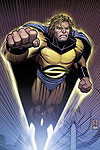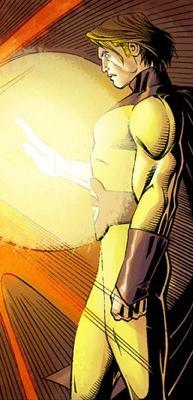The Sentry #1 (Vol. 2)
 "The Sentry : Act One"
"The Sentry : Act One"
Publisher Marvel
Written by Paul Jenkins
Pencilled by John Romita Jr.
Inked by Mark Morales
The Sentry. He's one of Marvel's oldest superheroes. Mr. Fantastic was best man at his wedding. The Hulk was his sidekick. He and the X-Men fought side by side to improve mutant-human relations. The problem is, no-one except him remembers. Not even you.
Such was the gimmick for the Sentry's first miniseries, which told the story of Robert Reynolds, a drunk and depressed man who just might've been the greatest hero who ever lived - or a loser with a failing grip on reality. He eventually regained his powers and restored everyone's memory, only to discover that he had also revived his alter-ego and arch nemesis, the Void. Defeating the Void was simple. Put the powers away, stop being the Sentry, and the Void would disappear as well. The only problem is, he'd once again become drunken loser Rob Reynolds. A sacrifice he was thankfully willing to make - after all, he's a hero.
The details of what happened next are unimportant (not to mention a little confusing). To keep it simple, in a recent New Avengers arc Rob Reynolds re-emerged as the Sentry, repressed the Void, regained his powers, joined the Avengers and began life as a hero with more or less a clean slate - it's as if the public never knew him. He's got his allies who do remember him, though, and with the return of his powers comes the return of his base, the Watchtower, and its sentient computer CLOC.
 |
Which brings us to the beginning of this, the second Sentry miniseries. Again written by Paul Jenkins, and this time with art from John Romita Jr. we begin as the Avengers repel an attack on New York by Attuma, the Atlantean warlord. With the forces defeated as a result of his actions, the Sentry immediately flies halfway around the globe to save people from a Volcano eruption. Then he engages jets in combat. Then yet more. The Sentry is like Superman with a better work ethic, or at least, a computer that tells him what his next choice should be. With all the options available, the Sentry simply can't decide for himself. Could you see in the long term which is more important - filming a public service announcement that reaches millions, or preventing a family from dying in a car crash a thousand miles away? Neither can he - but CLOC can.
So this is how we find the Sentry, running from disaster to disaster, saving the world from falling no matter how small the stumble. It's possibly familiar territory. With his tale of a broken man becoming addicted to the responsibility of having god-like powers, Jenkins is veering perilously close to simply retreading Miracleman territory. It's fair to say, though, if he's going to aim high, he should aim for the highest. It may be similar in theme but it's not necessarily similar in execution. The main departure from Miracleman is the Void - Reynolds' biggest enemy is himself, in a quite literal sense. Though the Void is repressed, in one of Jenkins' most chilling scenes, the Sentry sits down in an empty room and holds a conversation with the Void, and we begin to realise - he's not gone. He's never going to be gone. And one day, he's coming back.
It casts a shadow over Reynold's life as a hero, which is in turn casting a shadow over his marriage. He spends more and more time as the Sentry, neglecting his wife. When he's not the Sentry, he's seeing his psychiatrist, trying to work out the issues which fuel the Void. Schizophrenia. Agoraphobia. Jenkins has truly taken the concept of a "flawed hero" to the next level here, because the Sentry isn't just flawed, he's genuinely mentally ill. It's likely that this mini-series will deal with how someone like that can shoulder the responsibility of saving the whole planet, and more importantly, what happens when they can't.
Jenkins is at the top of his game here. It's a single-issue story which paints a picture of an unbalanced individual secretly enjoying the magnificent scope of his power, and the control that's giving him over life and death. Clearly, this is something that should worry us. It's a wonderful introduction to what looks like it's going to be some of his most entertaining work.
Romita's art does the script justice. It's bound to be hard for him to follow Jae Lee onto the character, but his experience and pedigree are allowing him to keep up with the material. He's never going to be a hot artist, but arguably that's because he's too good at what he does. He's not about creating a cult of Romita, like some artists can be, he's about getting the story out, and getting it out on time, without comprimising on quality. He's a professional storyteller and the small grin the Sentry gives himself on the final page, as he chases a crashing space shuttle, proves beyond all doubt that Romita is right for ths job, because in the slightest of expressions, you can see the threads beginning to unwravel. That, friends, is how comics need to be drawn.
As an excellent start to what is proving to be an original and compelling addition to the Marvel Universe, you should have no doubt that Jenkins and Romita's Sentry is going to be worth your money. Save yourself the wait and pick up issue #1 today. A+
Other Reading:
Wikipedia - The Sentry
Ninth Art - Moore's Marvel: The Miracleman Story
About this entry
- By James Hunt
- Posted on Saturday, October 01 2005 @ 4:36 pm
- Categorised in Comics
- 0 comments
